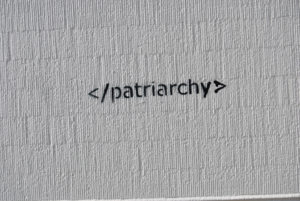 Society is divided according to gender, among other factors. Gender as John Zerzan writes in his book, Patriarchy, Civilisation and the Origins of Gender, is not the same as the differences and distinctions between the sexes, but is rather a “cultural categorisation and ranking grounded in a sexual division of labour that may be the single cultural form of greatest significance.” It is therefore inferable that gender does legitimise inequality and domination. With the purportedly continued increment in the bifurcation of both genders, the segmentation gained a definitive form, culminating in the birth of patriarchy.
Society is divided according to gender, among other factors. Gender as John Zerzan writes in his book, Patriarchy, Civilisation and the Origins of Gender, is not the same as the differences and distinctions between the sexes, but is rather a “cultural categorisation and ranking grounded in a sexual division of labour that may be the single cultural form of greatest significance.” It is therefore inferable that gender does legitimise inequality and domination. With the purportedly continued increment in the bifurcation of both genders, the segmentation gained a definitive form, culminating in the birth of patriarchy.
The origins of patriarchy, as Gerda Lerner explains in her book The Creation of Patriarchy, started with the first brush with the division of labour that began in the second millennium BC in Babylon, where women’s sexuality was totally controlled by men. The commodification of women’s sexual and reproductive capacity, she explains, occurred before the formation of private property and class society. The underlying interest, therefore, was to maintain a patriarchal family structure – one in which the dominance of the male thrives. In the process, in those days, erstwhile states and city-states were built on the conceptual framework of patriarchy and pursued the agenda of maintaining the institutional patriarchal structure. Slowly, this led to the institutionalisation of control over women’s sexuality through legislation, policy and economic structures. With time, it became something of a “norm”, where those that owned means of production could dominate over those who didn’t – which put men in a place of dominance, for the division of labour came into place. Accordingly, women came to be defined by their association with men. Those who were attached to one man, and one who controlled her sexual and reproductive capacity at that, were “respectable”, as Gerda Lerner explains. And those that were not attached – well, were “not-respectable”.
Our first lessons in patriarchy commence with our families. Specific roles and conduct are ascribed and are expected of children of both sexes – and with that, a subliminal understanding of the bifurcated statuses is inculcated. This is then systemically built upon with time, as children grow to become adults that encourage and perpetrate the same beliefs, and a continuous cycle is then created. In peacetime, patriarchy remains a part of the social fabric, propping up gender equality. In conflict, patriarchy manifests itself through war-strategy in the form of gender-based violence that culminates in war crimes and genocide. Irrespective of whether it is peace or conflict, therefore, there is always a simmering undercurrent of prevailing patriarchy.
Patriarchy literally means rule of the father in a male-dominated family. It is a social and ideological construct which considers men (who are the patriarchs) as superior to women.
In sum, patriarchy is structured around an institution of power-based relations. Therefore, it is but a given that these structures are hierarchical and unequal, with men holding the reigns over women’s rights over sexuality and reproduction. Patriarchy segregates the sexes and crafts “gender roles”, or thresholds that it predetermines as acceptable for men and women, and expects conformity therein. It does not, therefore, account for the third gender, or so much as even acknowledge it. While the underlying element remains the same, i.e., control, the manifestations of control vary with other social attributes such as class, caste, religion, region, ethnicity, traditions and socio-cultural practices.

About the author
Kirthi Jayakumar is a lawyer, writer, artist and activist. She founded and runs The Red Elephant Foundation, a civilian peacebuilding initiative built on values of storytelling.